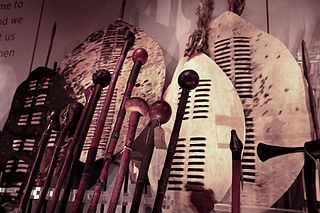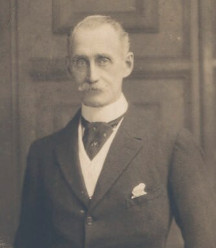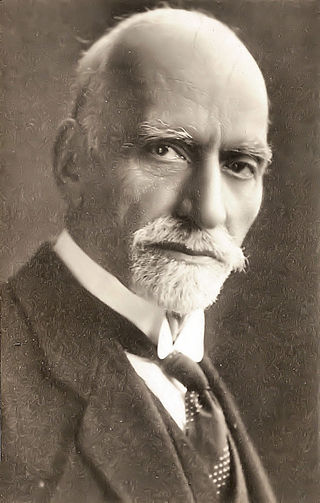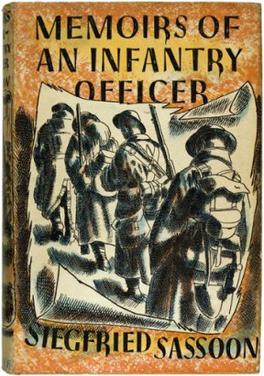Related Research Articles

Siegfried Loraine Sassoon was an English war poet, writer, and soldier. Decorated for bravery on the Western Front, he became one of the leading poets of the First World War. His poetry both described the horrors of the trenches and satirized the patriotic pretensions of those who, in Sassoon's view, were responsible for a jingoism-fuelled war. Sassoon became a focal point for dissent within the armed forces when he made a lone protest against the continuation of the war with his "Soldier's Declaration" of July 1917, which resulted in his being sent to the Craiglockhart War Hospital. During this period, Sassoon met and formed a friendship with Wilfred Owen, who was greatly influenced by him. Sassoon later won acclaim for his prose work, notably his three-volume, fictionalised autobiography, collectively known as the Sherston trilogy.

Wilfred Edward Salter Owen MC was an English poet and soldier. He was one of the leading poets of the First World War. His war poetry on the horrors of trenches and gas warfare was much influenced by his mentor Siegfried Sassoon and stood in contrast to the public perception of war at the time and to the confidently patriotic verse written by earlier war poets such as Rupert Brooke. Among his best-known works – most of which were published posthumously – are "Dulce et Decorum est", "Insensibility", "Anthem for Doomed Youth", "Futility", "Spring Offensive" and "Strange Meeting". Owen was killed in action on 4 November 1918, a week before the war's end, at the age of 25.

William Halse Rivers Rivers was an English anthropologist, neurologist, ethnologist and psychiatrist known for treatment of First World War officers suffering shell shock, so they could be returned to combat. Rivers' most famous patient was the war poet Siegfried Sassoon, with whom he remained close friends until his own sudden death.

Memoirs of a Fox-Hunting Man is a novel by Siegfried Sassoon, first published in 1928 by Faber and Faber. It won both the Hawthornden Prize and the James Tait Black Memorial Prize, being immediately recognised as a classic of English literature. In the years since its first appearance, it has regularly been a set text for British schoolchildren.

Regeneration is a historical and anti-war novel by Pat Barker, first published in 1991. The novel was a Booker Prize nominee and was described by the New York Times Book Review as one of the four best novels of the year in its year of publication. It is the first of three novels in the Regeneration Trilogy of novels on the First World War, the other two being The Eye in the Door and The Ghost Road, which won the Booker Prize in 1995. The novel was adapted into a film by the same name in 1997 by Scottish film director Gillies MacKinnon and starring Jonathan Pryce as Rivers, James Wilby as Sassoon and Jonny Lee Miller as Prior. The film was successful in the UK and Canada, receiving nominations for a number of awards.

The Ghost Road is a war novel by Pat Barker, first published in 1995 and winner of the Booker Prize. It is the third volume of a trilogy that follows the fortunes of shell-shocked British army officers towards the end of the First World War. The other books in the trilogy are Regeneration and The Eye in the Door.

Craiglockhart Hydropathic, now a part of Edinburgh Napier University and known as Craiglockhart Campus, is a building with surrounding grounds in Craiglockhart, Edinburgh, Scotland. As part of a large extension programme by the university in the early 2000s the original building and surrounding campus underwent significant restoration and modernisation; as a result, many of the original interior features of the building are no longer visible. The exterior of the building has been preserved.

Faber and Faber Limited, commonly known as Faber & Faber or simply Faber, is an independent publishing house in London. Published authors and poets include T. S. Eliot, W. H. Auden, Margaret Storey, William Golding, Samuel Beckett, Philip Larkin, Ted Hughes, Seamus Heaney, Paul Muldoon, Milan Kundera and Kazuo Ishiguro.
Robert Smith Surtees was an English editor, novelist and sporting writer, widely known as R. S. Surtees. He was the second son of Anthony Surtees of Hamsterley Hall, a member of an old County Durham family. He is remembered for his invented character of Jorrocks, a vulgar but good-natured sporting cockney grocer.
Vivian de Sola Pinto was a British poet, literary critic and historian. He was a leading scholarly authority on D. H. Lawrence, and appeared for the defence in the 1960 Lady Chatterley's Lover trial.
The sport of cricket has long held a special place in Anglophone culture, and a specialised niche in English literature. Cricket is the official summer sport in England, and it is widely known as the "gentleman's game", owing to the unique culture of the sport and its emphasis on ideals such as grace, sportsmanship, character and complexity. Cricket has therefore often attracted the attention of the literati – Lamb, Hazlitt and Leigh Hunt were all players of the game – and some of the greatest English writers have written about cricket. This was particularly true in the era before the Second World War, for example, during the Edwardian era, and in the 1920s and 1930s.

A knobkerrie, also spelled knobkerry, knobkierie, and knopkierie (Afrikaans), is a form of wooden club, used mainly in Southern Africa and Eastern Africa. Typically they have a large knob at one end and can be used for throwing at animals in hunting or for clubbing an enemy's head. For the various peoples who use them, they often have marked cultural significance. Being able to carry the knobkerrie has also had a political dimension, especially in South Africa.

Lieutenant-Colonel Henry Gilbert Ralph Nevill, 3rd Marquess of Abergavenny DL, styled Lord Henry Nevill between 1876 and 1927, was a British peer.

Regeneration is a 1997 British film, an adaptation of the 1991 novel of the same name by Pat Barker. The film is directed by Gillies MacKinnon. It was released as Behind the Lines in the US in 1998. The film follows the stories of a number of officers of the British Army during World War I who are brought together in Craiglockhart War Hospital where they are treated for various traumas. It features the story of Siegfried Sassoon, his open letter reprinted in The Times criticising the conduct of the war and his return to the front.

Sir Sassoon Eskell, KBE was an Iraqi statesman, financier and politician. Also known as Sassoon Effendi, he was regarded in Iraq as the Father of Parliament. Eskell was the first Minister of Finance in the Kingdom and a permanent Member of Parliament until his death. Along with Gertrude Bell and T. E. Lawrence, he was instrumental in the creation and the establishment of the Kingdom of Iraq post-Ottoman rule, and he founded the nascent Iraqi government's laws and financial structure.

Memoirs of an Infantry Officer is a novel by Siegfried Sassoon, first published in 1930. It is a fictionalised account of Sassoon's own life during and immediately after World War I. Soon after its release, it was heralded as a classic and was even more successful than its predecessor, Memoirs of a Fox-Hunting Man.

Sherston's Progress, published in 1936, is the final book of Siegfried Sassoon's semi-autobiographical trilogy. It is preceded by Memoirs of a Fox-Hunting Man and Memoirs of an Infantry Officer.
Second Lieutenant David Cuthbert Thomas was a Welsh soldier of the British Army who served during the First World War. He is best known for his association with the poet Siegfried Sassoon, who after his death became the subject of some of the greatest war poems by Sassoon and Robert Graves.
Undertones of War is a 1928 memoir of the First World War, written by English poet Edmund Blunden. As with two other famous war memoirs—Siegfried Sassoon's Sherston trilogy, and Robert Graves' Good-Bye to All That—Undertones represents Blunden's first prose publication, and was one of the earliest contributors to the flurry of Great War books to come out of England in the late 1920s and early 1930s.
Fox hunting is an activity involving the tracking, chase and, if caught, the killing of a fox.
References
- ↑ "Description of the book from Amazon". www.amazon.com. Retrieved 2020-08-18.
- ↑ "SHERSTON TRILOGY, including: MEMOIRS OF A FOX-HUNTING MAN [and]MEMOIRS OF AN INFANTRY OFFICER [and] SHERSTON'S PROGRESS by Sassoon Siegfried: (1936) Signed by Author(s) | Buddenbrooks, Inc". www.abebooks.com. Retrieved 2020-08-18.